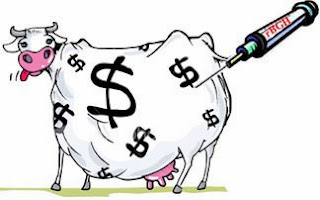Despite all the controversy over the use of hormones such as rBGH in dairy production, the benefits to milk production are clear and hard to dispute. In some cases, milk production in cows could increase by 11 percent, and in other cases up to a whopping 40 percent.Regardless, this increase in production translates into profit as more milk is sold or alternatively, less cows need to be owned. This is an extremely effective means of increasing milk yield meanwhile utilizing environmentally friendly techniques. By utilizing such hormones, there would be a decrease in cow ownership leading to decreased manure and other waste produced by cattle. Despite belief, owning 10% more cattle (by eliminating use of rBGH) to produce the same amount of milk being produced today would probably cause more economic hardship as well as troublesome environmental variances.
 |
| The increase in milk yield per cow translates into profit as more milk is sold and ultimately, less cows are raised. |
There are also apparent benefits for consumers of milk products. Studies show that the demand for dairy products is on the rise. The USDA Foreign Agricultural Service reports that for the first half of 2010, exports of cheese were up 48% and exports of butter were up 89%. With the use of hormones such as rBST, the ability for U.S. dairy producers to meet this demand would become more probable, providing the public with means of purchasing milk at a reasonable price and rate. Even with less cows owned, more milk would be produced. Although normally after the cow calves, milk is produced for about 12 weeks afterwards, the introduction of recombinant hormones into the body can postpone the dry period allowing for another eight to 12 weeks of lactation, and respectively, more milk from each cow. Because milk has always been a great, sustainable source of nutrients to individuals ranging from newborns to elderlies, the demand will stay the same if not increase rapidly with the increase in population size and therefore demand. Because also there would be less costs for the farmers in raising less dairy cattle, economically the prices would stay the same or decrease as demand continued to rise.
As for the health aspect, because this is an already naturally occurring within the body, it seems evidently safe to introduce it into consumers' milk supply. Furthermore, because the hormone cannot remain active within the harsh conditions of the human digestive tract and ultimately cannot be recognized when absorbed into the body, the introduction of these extra hormones into the milk supply would produce no negative effects to a natural hormone balance.
Bet despite the apparent benefits, all farmers still care about the well being of their animals. Recent studies have shown that increased cases of infections such as mastitis are associated with the use of recombinant hormones such as these in dairy cattle. It is said that this is due simply to the overworking of the cow. That increase in lactation period as discussed before could cause potentially life threatening health situations onto the cow. After the cow lactates for the normal 12 weeks after calving, the cow's body is able to recover as it had been diverting nutrients away from maintenance and sourcing towards production. But, with the increased period of lactation, cows are unable to divert energy and nutrients back to maintenance when needed, as is the case when fighting off infection. Because this is the case, there has been an increase in relevancy of mastitis cases as well as other illnesses commonly seen within dairy production. Although there are new methods that are continuously being developed to treat mastitis and other ailments, would the cost of treating these animals still pale in comparison to the profit being made with the use of rBGH and other hormones like these?
 |
| There has been an increase in mastitis cases associated with the use of rBGH due to the overworking of dairy cattle. |
Sources
http://www.fda.gov/animalveterinary/safetyhealth/productsafetyinformation/ucm130321.htm
No comments:
Post a Comment